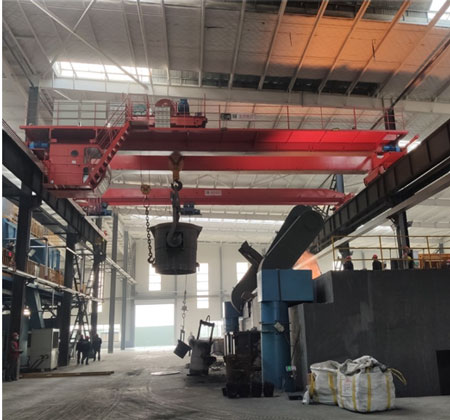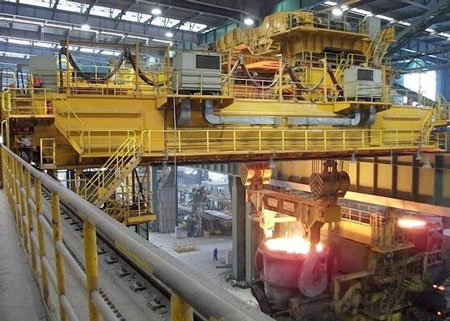A metallurgical crane is a specialized overhead crane designed for handling molten metals in environments such as foundries, steel mills, and metallurgical plants. They are categorized into single-girder and double-girder configurations. According to Section 5 of the Crane Design Standards (Overhead and Gantry Cranes), metallurgical cranes must meet all the requirements of standard overhead cranes, plus additional critical specifications to ensure safety and reliability in extreme conditions, as below.

Heat radiation protection & fireproof plates
- For overhead cranes handling molten metals or hot materials, a heat radiation protection plate shall be installed at the bottom of the operator’s cabin, which is exposed to direct heat radiation.
- Overhead cranes handling molten metals or hot materials (excluding those using the lower flange as a runway) shall have heat radiation protection devices installed at the bottom of the main girder and lifting beam.
- For overhead cranes using the lower flange as a runway to handle molten metals or hot materials, a heat radiation protection device shall be installed under the lifting trolley.
- Heat radiation plates shall be secured with anti-falling mechanisms.
- Overhead cranes exposed to direct flames (e.g., charging cranes in steel mills) shall have fireproof plates installed on main structural components in direct contact with flames.
- Heat insulation layers shall be applied to walkways or platforms exposed to radiation.
- Electrical equipment exposed to heat radiation shall be protected with heat-resistant shielding.
Operator cabin requirements for a metallurgical crane
Overhead cranes handling molten metals or hot materials shall use fully enclosed operator cabins with independent flame-retardant insulation layers.
Mechanisms for metallurgical cranes
- Main hoisting mechanism (excluding electric hoists)
- Equip dual independent drives with rigidly connected output shafts
- If drives are not rigidly connected or only one drive is used, install a safety brake on the wire rope drum. *Note: Dual drives = 2 motors + 2 gear systems + 1/multiple drums + 4 brakes.*
- For overhead cranes ≤ 16 ton, the hoisting mechanism’s duty class shall be ≥2 grades higher than operational requirements, with a minimum of M5.
- Dual hooks: 4-rope reeving system
- Single hooks: 2-rope reeving system
- Safety factor ≥5.6 for overhead cranes ≤16t (per GB/T 3811)
- Prohibit balance pulleys in wire rope systems
- Electric hoist requirements (≤ 16 ton)
- For hoists >5 ton, dual brakes (primary brake + safety brake on low-speed stage)
- For hoists ≤5 ton, safety brake recommended, otherwise, design for 1.5× rated load
- Use high-temperature-resistant hoists with M6 duty class
- Hoists handling vertically quenched hot workpieces shall have emergency brake release devices
- For overhead cranes handling impact loads (e.g. forging cranes), install buffers and brake release mechanisms
Component requirements for metallurgical cranes
- Use heat-resistant steel-core ropes (≥GB 8918 standards)
- Safety factor ≥5.6 for overhead cranes ≤16 ton
Avoid gray cast iron pulleys. Use rolled steel pulleys or cast pulleys meeting GB/T 27546.
- Welded forks: Load direction aligned with steel grain; material ≥Q345B (GB/T 1591)
- No butt welds on lower flanges of lifting beams
- Critical components (e.g., pulley side plates): Ultrasonic testing (UT) ≥GB/T 2970 Grade I
- Protect wire ropes from heat radiation and molten splatter
- Install anti-splash guards for hooks immersed in liquids
- For billet-handling cranes: Use Q345 steel teeth with full-penetration welds, post-weld annealing, and UT/RT testing (≥GB/T 3323 BII/JB/T 10559 Grade I)

Brake Control
Prevent brake failure caused by single contactor faults (e.g., welding/sticking).
Cables
Use flame-retardant, heat-resistant cables or apply heat insulation to cables exposed to radiation.
Operation Modes
Operate via enclosed cabins, remote control, or non-following modes with clear visibility. Remote-controlled overhead cranes must have operator access pathways.
Overspeed Protection
Install over speed protection for hoisting mechanisms (excludes ≤ 5 ton electric hoists).
Dual Limit Protection
For molten metal overhead cranes: dual ascending limit switches (controlling separate circuits), descending limit switches required if lifting height ≤20m.
Safety Brake Redundancy
For overhead cranes handling molten metals:
If dual drives lack rigid connections or use a single drive, install drum-mounted brakes.
Electric hoists (5 ton < capacity ≤ 16 ton): dual brakes (primary + low-speed safety brake).
Electric hoists ≤5 ton: Safety brake recommended; otherwise, design for 1.5× rated load.
Solution
Metallurgical cranes are high-risk equipment. Purchase only from certified manufacturers and comply with special inspection requirements.